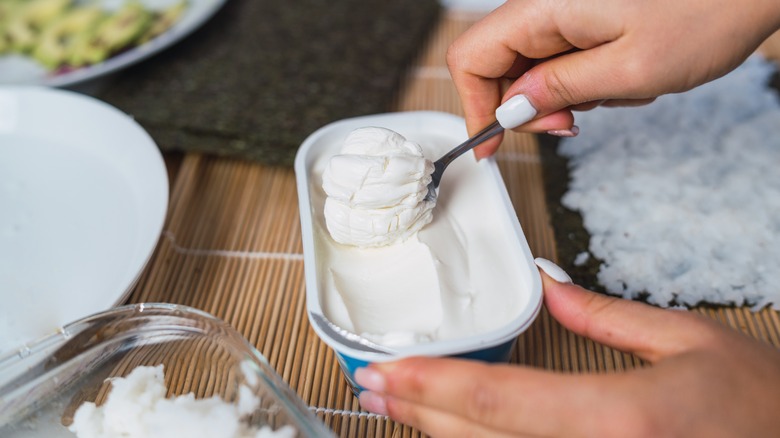Here's How Long You Can Eat Cream Cheese After Opening
A little bit of cream cheese tends to go a long way — or if you like to use a lot, you probably buy a huge tub — so it's common to end up with quite a bit left over that ends up languishing in your fridge. Even if you're a bagel fanatic or frequent cheesecake baker, you might wonder how quickly you need to use up cream cheese before it goes bad. The answer is somewhat complicated, as the cheese will degrade in quality greatly before it actually becomes unsafe to eat.
Yes, you should toss cream cheese if it takes on a yellowish color, develops signs of mold or sliminess, or if it starts to get hard and dry, but you'll want to use it up way before then, as it will start to taste "off" much earlier. According to the USDA, refrigerated cream cheese is safe to eat for up to two weeks after opening. However, it will retain its flavor and quality for just a week to 10 days. The flavor will noticeably degrade after this point, as it starts to lose its sweet tanginess and takes on a dull taste, instead.
As a fresh, unaged cheese, cream cheese tastes best when it is first opened, and quickly loses freshness as it dries out or absorbs odors from the fridge. Be wise with your storage practices, though, and you can help the cheese keep its best qualities for as long as possible.
How to store cream cheese for the maximum lifespan
Unlike a firm or hard cheese like cheddar, you can't just leave cream cheese in a half-opened package in the fridge. You'll want to make sure that any unused portions are sealed tightly in an airtight container or bag, and refrigerated at 40 degrees Fahrenheit or colder. Try to keep it at the back of the fridge on a shelf, since the door of your fridge shouldn't be used to store dairy like milk and cheese.
You can also freeze the leftovers for two months, but this will cause a change in texture. Once thawed, cream cheese will become grainy and lose its silky-smoothness. Consider how you'll be using it to decide if it's worth freezing — it might be okay blended into a sauce or dressing, or perhaps whipped into a cheesecake, but won't be great for eating alone on toast. Whether you freeze opened or unopened cream cheese, place it in a freezer-safe plastic bag first.
Cream cheese is at its most spreadable when brought to room temperature, but whether it's from the fridge or freezer, you shouldn't leave a package of cream cheese on the counter to soften. If you forget about it for two hours or longer, it can spoil. Instead, scoop out or cut off only the amount you want to use and pop it in the microwave for a few seconds at a time until soft.
Ways to use up that leftover cream cheese
Cream cheese has plenty of uses beyond cheesecakes and bagels. The smooth and tangy spread is excellent on top of toasted raisin bread and warm banana bread, and it adds another dimension to cinnamon sugar toast when used in place of butter. For another sweet breakfast treat, try making strawberry and cream cheese waffle sandwiches. You don't even need to make your own waffle batter for these fruity treats.
When it's past breakfast time, but you're feeling peckish before lunch, fill celery slices with cream cheese and sprinkle with everything bagel seasoning for a crunchy snack. To make snacks for a crowd, simply mix the cheese with garlic and herbs or a bit of ranch seasoning to make a fun chip dip. And while cheese and charcuterie boards usually include "fancier" cheeses, cream cheese makes for a delicious creamy addition that's perfect on crackers with fig jam or other preserves.
Cream cheese also tempers and balances spicy foods, so consider using the rest of that package to make stuffed jalapeño poppers. You can also add it to Mexican chile rellenos, where the silky creaminess will compliment the other cheeses in the recipe, or use it to dress ground beef enchiladas. With so many options, you shouldn't have any issues polishing off a package of cream cheese within a week of opening.



